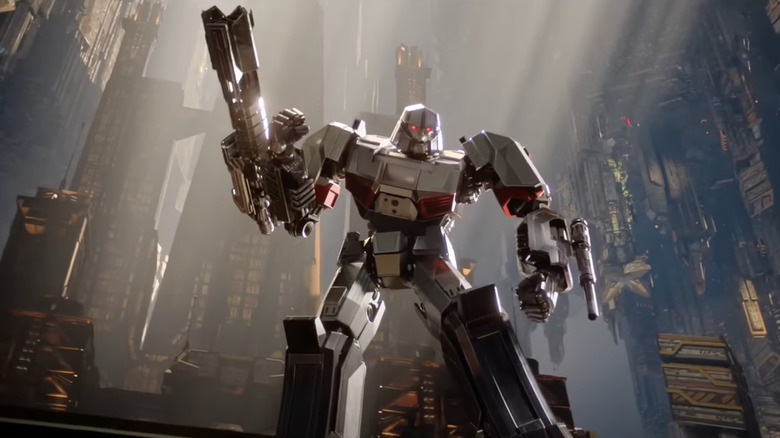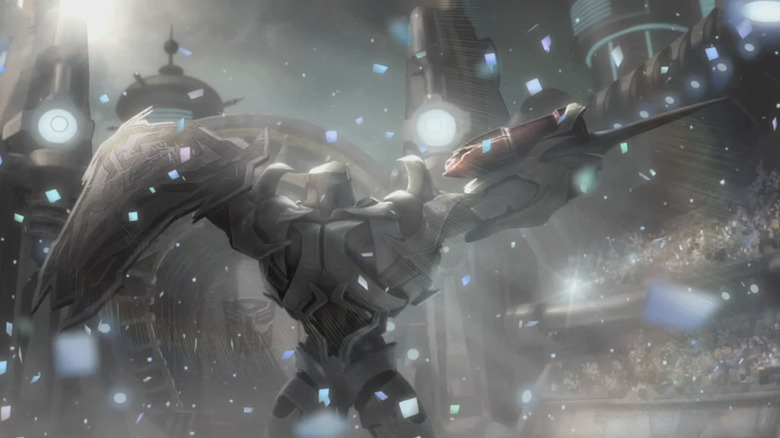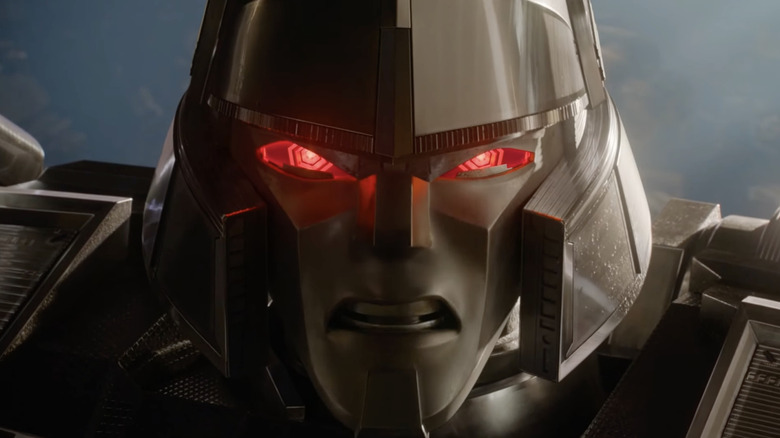Transformers One Cut A Megatron Backstory Right Out Of Gladiator
We may receive a commission on purchases made from links.
The "Transformers" cartoons got their hooks into me as a kid, and to this day I care more about these Robots in Disguise than I probably should. Director Josh Cooley's animated prequel "Transformers One" is, honestly, the "Transformers" movie I wanted when I was 12, even more so than Travis Knight's also very good "Bumblebee." (Let's forget about the unimaginative, milquetoast "Rise of the Beasts" that came in between them, right?)
"Transformers One" is a prequel film, showing how Optimus Prime and Megatron went from best pals to leading a war on opposite sides. Ever wondered why Decepticons brand themselves with a name evoking "Deception"? This is the movie for you!
In "Transformers One," Orion Pax (Chris Hemsworth) and D-16 (Brian Tyree Henry) are Energon miners on a pre-war Cybertron, toiling away together underground. Like other members of their miner class, the pair do not have the "cogs" necessary to transform. D-16 prefers to stay on protocol, while Orion dreams of a better future. Then, when they learn a dark truth about Cybertron's leader Sentinel Prime (Jon Hamm), the two friends go down diverging paths to reshape their planet's future.
This is similar to many previous "Transformers" series, but with some different details. Megatron's usual character arc is that he started as a miner designated D-16, but then became a gladiator to blow off steam; it was only when fighting in the pits that he had the ability to make his own destiny. He then took the name "Megatron" from the legendary warrior Megatronus Prime, and the Decepticons rose out of both Megatron's fellow gladiators and adoring fans. "Transformers One" skips over this middle step: Megatron goes straight from a miner to a revolutionary.
Speaking to IndieWire in June 2024, Cooley confirmed that he considered showing Megatron's gladiator stage, but the film ultimately didn't have the time for it. "If we had all the time in the world, it would've been fun to show Megatron as a gladiator and have the two characters come from very different backgrounds. We actually had a gladiator scene that alluded to this origin that was cut out," said Cooley.
Megatron as a gladiator goes back to the beginnings of Transformers
The first reference to Megatron as a former gladiator is in the "Transformers Annual 1986," part of the UK-exclusive run of "Transformers" comics published by Marvel. In the issue is a prose story written by James Hill titled "State Games." Set on a prehistoric Cybertron, this story depicts Optimus Prime and Megatron as rival gladiators. (Prime representing the nation-state Iacon, and Megatron representing the city of Tarn.) After a civil war between Tarn and its rival city Vos, Megatron unites the survivors against Iacon, fighting under his banner as Decepticons.
Simon Furman, who wrote most of the Marvel "Transformers" comics, must've remembered "State Games." In 2002, he wrote the new comic mini-series "Transformers: The War Within," another Cybertron-set prequel where Megatron was a former gladiator. ("War Within" was drawn by Don Figueroa and published by the now-defunct Dreamwave.)
The 2007 comic "Megatron Origin" (by Eric Holmes and Alex Milne) again showed Megatron as a gladiator, while adding the idea that before that, he was a low-class miner. This added a new shade to the Decepticons: their struggle wasn't just for conquest, but for class revolution, especially since the Autobots were depicted as originally being Cybertron's police force. How, then, did the Decepticons become imperialists while the Autobots became freedom fighters? That's a contradiction I think only "Transformers One" has squared. (More on that soon.)
Due to constant reboots by different creators, the first two decades of "Transformers" are pretty scattershot. It was only in the 2010s that parent company Hasbro started streamlining. Character names and designs would be used more consistently, and each new "Transformers" series would have the same fundamental lore about who created the Transformers, why the war started, etc.
2010's "Transformers: Prime" was the first cartoon to bring a lot of previously comic-exclusive lore to animation, including Megatron's gladiator backstory. "Prime" Megatron (voiced again by the OG Frank Welker) won the crowd, leading the masses of the city-state Kaon to revolution against Cybertron's oppressive caste system. Of course, in the present, he's the same ol' warlord as ever — 'cause all revolutions are corrupt, right?!
Throughout "Transformers: Prime," Megatron was shown to be very proud of his roots. In the episode "Crossfire," he's ambushed and locked inside a makeshift arena opposite a powerful Insecticon. Still, though, he triumphs, and after decapitating the bug, he bellows: "Let that be a warning to anyone who dares cross a gladiator of Kaon, be they Decepticon or Autobot!"
In the 2012 video game "Transformers: Fall of Cybertron," Megatron finds himself back in the gladiatorial pits, cutting down treacherous Decepticons led by a usurping Starscream. Megatron boasts that he had already proved his worthiness to lead in that very same arena. "That day has long passed, Megatron," Starscream sneers, to which Megatron fires back: "That day will live forever!"
What is the superior Megatron origin?
So, did "Transformers One" miss out by not including Megatron's backstory as a gladiator? I think this is a symptom of how the movie could benefit from being 15-20 minutes longer. It's not rushed, and the character motivations always track, but only having 104 minutes to show the shattering of a friendship and the transformation of a world means there's little breathing room. Throw in another scene where D-16 spends his free time fighting as a gladiator? That'd establish both his hidden anger and why he's such a powerful fighter.
But even without this detail, "Transformers One" is the best rendition of the "Optimus and Megatron were brothers once" backstory. In previous versions, Orion Pax and Megatron come from two different worlds; Orion is usually in a relatively higher-class job, like a data clerk or a police detective. They only meet after Megatron is a gladiator, whereas in "Transformers One," they basically grew up together, which adds emotional weight to their falling out. Streamlining the story so both Orion Pax and Megatron were miners fixes the political themes too.
As I said above, too, previous tellings never really squared quite how Megatron goes from a freedom fighter to a tyrant — until "Transformers One." Both Orion and D-16 want to overthrow Sentinel Prime and his caste system, but only Orion has a clue of how to build something better. D-16 just wants revenge, and will kill anyone to get it. He was never a sincere revolutionary fighting for the people, that's who Orion is. Both bots call on their followers to rise up, but Orion tells the miners they must work together as one to become free Autobots, while D-16 wins over the future Decepticons by beating Starscream and declaring that only the strongest (and least merciful) can lead.
That leads us to the last detail "Transformers One" fixes. In many versions of "Transformers" (even the original cartoon), it's said that the Autobots were built to be laborers, and the Decepticons were built to be soldiers. (In the original toyline, the Autobots all turned into cars, while the Decepticons mostly turned into fighter jets, and Megatron himself into a gun.) I've always had problems with this, since it implies the Autobots and Decepticons are different species, not two groups of the same one. That then leads to the implication that Autobots are good and Decepticons are evil because that's what they're programmed to be, which robs the characters and their conflict of any agency.
"Transformers One" is the first time the franchise has pulled this off dichotomy without getting into robot race-science. Orion recruits his fellow miners as the Autobots, while Megatron recruits the Decepticons from soldiers in Cybertron's High Guard. The robots weren't created to belong to one group, but they go with the one that fits their pre-existing nature; oppressed workers will naturally respond to a message about freedom, just as soldiers will to a "might makes right" outlook.
Unfortunately, "Transformers One" did not impress at the box office, but I'd give my kingdom for Josh Cooley to get all the time he needs making a sequel.
"Transformers One" is now available to rent and purchase, including on digital streaming platforms.


